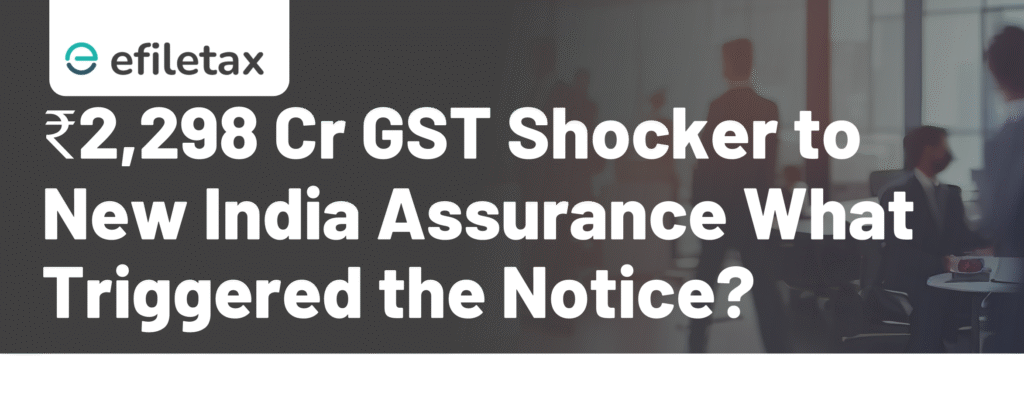
New India Assurance Gets ₹2,298 Cr GST Demand Notice: What It Means for the Insurance Sector
The New India Assurance Company Ltd (NIACL) has received a GST demand notice worth ₹2,298 crore from the Directorate General of GST Intelligence (DGGI) for five financial years. This massive demand — one of the highest on an insurance PSU — raises serious compliance and legal questions.
What Is the ₹2,298 Cr GST Demand About?
As per disclosures made to the stock exchanges on 26 June 2025, the notice was issued by the Mumbai Zonal Unit of the DGGI. It covers five financial years:
- FY 2017–18
- FY 2018–19
- FY 2019–20
- FY 2020–21
- FY 2021–22
The total tax demand stands at ₹2,298.1 crore, and New India Assurance has clarified that it is preparing a detailed response and will challenge the demand appropriately.
Why Was the GST Demand Raised?
While the exact details are not public yet, industry experts suggest likely areas include:
- Wrongful Input Tax Credit (ITC) claimed on exempt insurance services
- Incorrect classification of services leading to a lower GST rate
- Failure to reverse ITC for exempted policies under Rule 42/43 of CGST Rules
- Discrepancies in premium collection vs GST remitted
🧾 Legal Note: Rule 42 and Rule 43 of the CGST Rules, 2017 govern the reversal of ITC for input services used in both taxable and exempt supplies.
What Services Are GST Exempt in Insurance?
Here are some key exemptions relevant to the insurance sector:
| Service | Exempt under GST? | Notification Reference |
|---|---|---|
| Jan Dhan Yojana Insurance Schemes | ✅ Yes | Notification 12/2017-CT (Rate) |
| Life insurance under PMJJBY/PMFBY | ✅ Yes | Notification 12/2017-CT (Rate) |
| Group insurance for government employees | ✅ Yes | Notification 12/2017-CT (Rate) |
| Commercial insurance policies | ❌ No | Taxable @ 18% (standard) |
Legal Angle: Can GST Be Demanded Retroactively?
Yes — under Section 73 or Section 74 of the CGST Act, 2017, tax can be demanded within 3 to 5 years for non-fraud and fraud cases respectively.
However, such large retrospective demands often lead to litigation. The company has the right to:
- Reply to the Show Cause Notice (SCN)
- Appeal before the GST Appellate Authority or GSTAT
- Escalate to the High Court/Supreme Court if needed
Practical Tip from Experts
💡 “Insurance companies must review their ITC reversal computations and ensure internal audit checks for exempt and taxable supplies. Insurers cannot assume full ITC is eligible if part of the business is exempt.”
— CA Nikhil Rao, GST Consultant, Mumbai
GST Impact on Insurance: Key Lessons
- GST compliance in insurance is complex due to mixed supplies
- Exempt services still affect input credit eligibility
- Annual Reconciliation (GSTR-9C) must be accurate to avoid demands
- Departments are increasingly scrutinising PSU insurers and banks
Can You Be Impacted as a Policyholder?
No. This demand is not related to policyholders’ premiums or personal claims. It concerns the company’s internal tax compliance and does not affect your insurance coverage.
Efiletax Can Help Insurers Stay Compliant
Whether you’re a small insurance broker or a large financial company, Efiletax offers GST audit, reconciliation, and advisory services to help you avoid such notices.
✅ Input tax credit matching
✅ ITC reversal computation under Rule 42
✅ Legal drafting for SCN replies
✅ GST Return filing & audit support
Summary
New India Assurance received a ₹2,298 crore GST demand for FY 2017–22 from DGGI Mumbai. The case relates to alleged ITC and classification errors. Experts advise insurers to review Rule 42 ITC reversals. Efiletax helps insurers ensure GST compliance and avoid such disputes.
FAQs
Q1: Is the ₹2,298 crore GST demand final?
No. It’s a show cause notice. NIACL can respond and appeal through legal channels.
Q2: Can GST be demanded for five previous years?
Yes, under Sections 73 or 74 of the CGST Act depending on the nature of default.
Q3: Does this affect my insurance policy?
No. It does not impact individual policyholders or their claims.
Q4: What should insurers do now?
Reconcile input credit, review tax positions, and prepare for scrutiny.